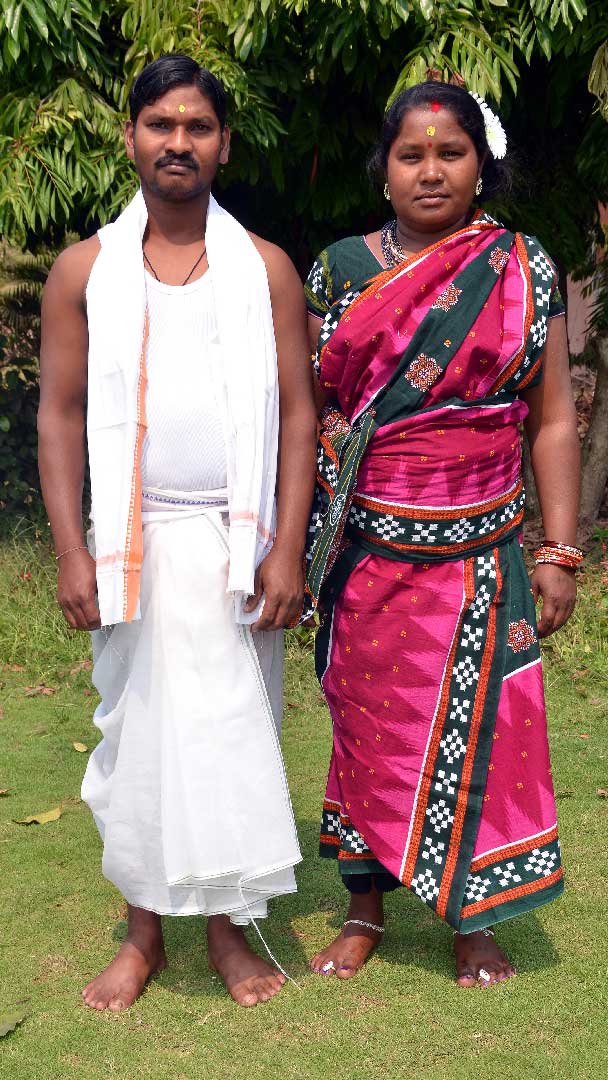TRIBES OF ODISHA
TRIBES OF ODISHA
Kharia
Kharian, Berga Kharia, Dhelki Kharia, Dudh Kharia, Erenga Kharia, Munda Kharia, Oraon Kharia, Khadia, Pahari Kharia
Region: Forests of Mayurbhanj and plains in Jharsuguda, Sambalpur and Sundergarh
Population*: 2,22,844
Language: Kharia
Map: Click Here
Origin: The Kharia are believed to have migrated to the region from river valleys north of the Vindhya and Kairmur ranges.
Occupation: The tribe is split into three groups; the Hill Kharia being the most primitive still survive as hunter-gatherers. Forest produce such as resin, honey and tussar cocoons forms their major source of income. The Dhelkai Kharia work as agricultural labour and the Dudh Kharia are settled cultivators; Spinning is another allied occupation and Kharia women also make mats of date palm leaves and bamboo and ropes of sabai fibre and aloe leaves.
*Scheduled Tribes Population as per Census 2011 data. PVTGs Population as per Micro Project Survey Data, 2010
Kharia
Kharian, Berga Kharia, Dhelki Kharia, Dudh Kharia, Erenga Kharia, Munda Kharia, Oraon Kharia, Khadia, Pahari Kharia
Region: Forests of Mayurbhanj and plains in Jharsuguda, Sambalpur and Sundergarh
Population*: 2,22,844
Language: Kharia
Map: Click Here
Origin: The Kharia are believed to have migrated to the region from river valleys north of the Vindhya and Kairmur ranges.
Occupation: The tribe is split into three groups; the Hill Kharia being the most primitive still survive as hunter-gatherers. Forest produce such as resin, honey and tussar cocoons forms their major source of income. The Dhelkai Kharia work as agricultural labour and the Dudh Kharia are settled cultivators; Spinning is another allied occupation and Kharia women also make mats of date palm leaves and bamboo and ropes of sabai fibre and aloe leaves.
*Scheduled Tribes Population as per Census 2011 data. PVTGs Population as per Micro Project Survey Data, 2010
Kharia
Kharian, Berga Kharia, Dhelki Kharia, Dudh Kharia, Erenga Kharia, Munda Kharia, Oraon Kharia, Khadia, Pahari Kharia
Region: Forests of Mayurbhanj and plains in Jharsuguda, Sambalpur and Sundergarh
Population*: 2,22,844
Language: Kharia
Map: Click Here
Origin: The Kharia are believed to have migrated to the region from river valleys north of the Vindhya and Kairmur ranges.
Occupation: The tribe is split into three groups; the Hill Kharia being the most primitive still survive as hunter-gatherers. Forest produce such as resin, honey and tussar cocoons forms their major source of income. The Dhelkai Kharia work as agricultural labour and the Dudh Kharia are settled cultivators; Spinning is another allied occupation and Kharia women also make mats of date palm leaves and bamboo and ropes of sabai fibre and aloe leaves.
*Scheduled Tribes Population as per Census 2011 data. PVTGs Population as per Micro Project Survey Data, 2010
Kharia
Kharian, Berga Kharia, Dhelki Kharia, Dudh Kharia, Erenga Kharia, Munda Kharia, Oraon Kharia, Khadia, Pahari Kharia
Region: Forests of Mayurbhanj and plains in Jharsuguda, Sambalpur and Sundergarh
Population*: 2,22,844
Language: Kharia
Map: Click Here
Origin: The Kharia are believed to have migrated to the region from river valleys north of the Vindhya and Kairmur ranges.
Occupation: The tribe is split into three groups; the Hill Kharia being the most primitive still survive as hunter-gatherers. Forest produce such as resin, honey and tussar cocoons forms their major source of income. The Dhelkai Kharia work as agricultural labour and the Dudh Kharia are settled cultivators; Spinning is another allied occupation and Kharia women also make mats of date palm leaves and bamboo and ropes of sabai fibre and aloe leaves.
*Scheduled Tribes Population as per Census 2011 data. PVTGs Population as per Micro Project Survey Data, 2010
PVTG Communities
62 Scheduled Tribes
PVTG Communities
62 Scheduled Tribes
PVTG Communities
62 Scheduled Tribes





